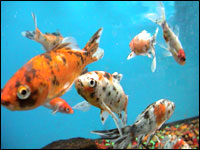Dear Umbra,
I’m an elementary school teacher and I’d like to get a pet fish for my classroom, but I’ve heard tales of such fish being caught by eco-egregious means: dynamite blasting, cyanide dumping, etc. How can I make sure I’m getting happy, healthy, sustainably caught fish for my aquarium?
Ginger
Dearest Ginger,
Is nothing sacred? Apparently not cute aquarium fish, which are wooing consumers to inadvertently destroy remote natural environments.

Fish-ful thinking.
Salt-water, aquarium-destined fish are indeed caught with cyanide. The fisherperson descends to the reef and squirts cyanide into nooks and crannies, stunning the fish, which naturally become easy catches. The cyanide tends, as you might imagine, to have a deleterious effect on the uncaught marine life, including coral, with implications for human subsistence and reef life. Captured fish may be sickly or near death. Not all marine fish are cyanide-caught, but the incentive to use nets is very low, since it’s far quicker and cheaper to use cyanide. (Dynamite fishing is another tactic but I gather that it generally results in dead fish for eating purposes. Egad.) Cyanide fishing is a big problem in the Philippines and Indonesia, and an increasing issue in other poor Pacific Rim countries. It’s not legal. It’s very bad.
A logical alternative would be farm-raised aquarium fish, but marine fish usually have a plankton life phase whose conditions are nigh impossible to replicate in captivity. There are, however, some farmed salt-water pets out there if you have your heart set on an ocean tank: a fish purveyor I spoke with mentioned clown fish as an example.
Luckily, salt water might not be your first choice for a classroom aquarium, which reduces your chances of buying a cyanide-poisoned fish from a dying reef.
Freshwater aquarium fish survive better under farm conditions, and the modern market includes farmed and wild-caught fish. Freshwater fish farming in the U.S. is dominated by inland ponds in Florida, where astute businesspeople create romantic fishy getaways conducive to egg-laying fun. It’s a cutthroat industry with heavy competition from overseas. You may know that food fish raised in open-water pens are increasingly recognized as an ecological disaster-in-the-making, what with antibiotics, disease, piles of poop, and escapist fish infiltrating the wild gene pool. So farmed dinner fish should be off your shopping list, but I’m going to recommend farmed aquarium fish. It’s true, I have not seen any explicit comparisons of the environmental impacts of aquarium fish farming and cyanide fish catching — but forgive my assumption that destroying reef ecosystems forever is worse than any fish poop generated in inland Florida.
Can the typical schoolteacher easily find nice farm-raised freshwater fish? I think so. Organizations such as the Marine Aquarium Council are attempting to make a difference by certifying sustainably caught fish, but your basic plan should be to find an independent aquarium shop and ask hard questions. I called two aquarium shops and both salespeople were aware of the problem of wild-caught fish, though neither knew of a certification program. They guaranteed me that no chain store would know a thing about where their fish came from. In terms of looking for a healthy fish, one salesperson’s tips were: avoid goldfish, and look for fish with clear eyes, unclamped fins, and overall vigor. You want a fish that’s swimming happily about, although he did say that “some fish are naturally shy and retiring.” Nice to know there’s a range of fish personalities, but I don’t think a reticent fish would be appropriate for a classroom.
Dorsally,
Umbra


